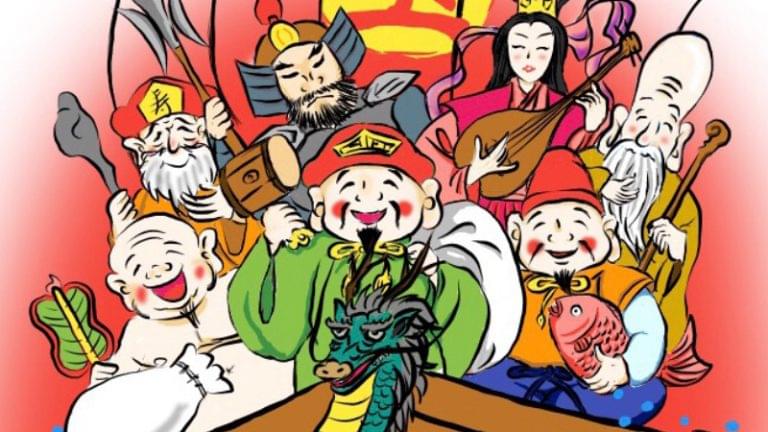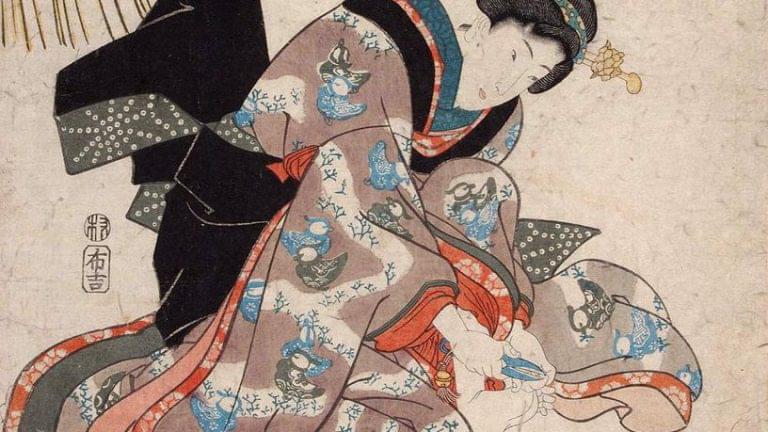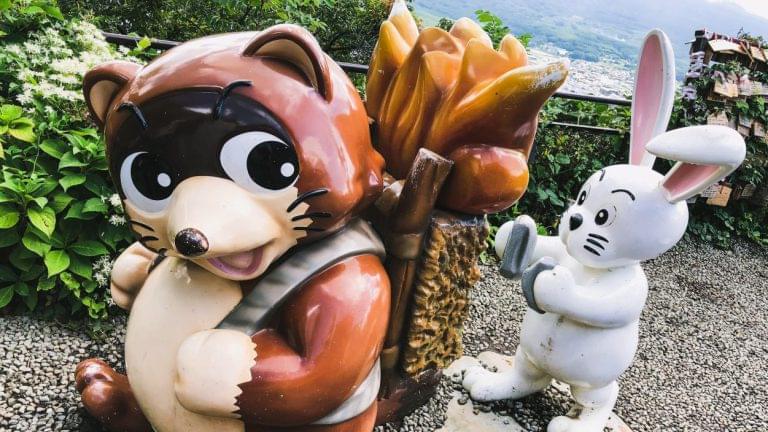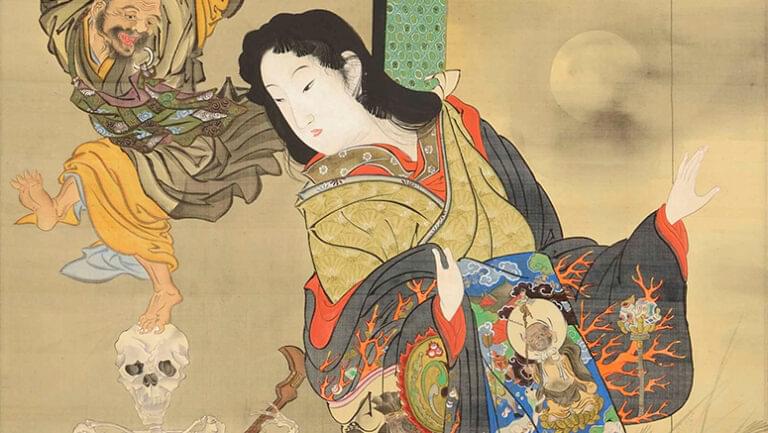Introduction to Uncanny Japan
Welcome to Uncanny Japan. I’m author Thersa Matsuura, and I’m here to share with you all the hidden more obscure corners of Japan. Join me as we explore strange superstitions, curious creatures and cultural enigmas.
Journey to the Dragon Palace
Here, come and walk with me along this beach. See that large sea turtle over there? Go ahead and climb on its back. Don’t worry. It’s not a normal sea turtle. Never ever climb onto the back of a normal sea turtle. That would be terribly mean. But this one’s magical. You know how I know? He talks. Watch.
“Get on!”
See. I’ll climb on mine. Today let’s journey down to the bottom of the ocean. Down, down, down to an underwater dragon palace called the Ryūgū or sometimes Ryūgūjō. It’s owned and lorded over by Ryūjin, the Dragon God. And while we’re there. Let’s learn more about all the myth and lore surrounding him and how you can personally connect with the spirit of the Dragon God. If you want.
Down, down, down. Still going down. There it is over there, rising beautifully luminescent in the utter blackness on the ocean floor.
The Magnificent Ryugujo
The dragon palace — the ryugujo — has been described in different ways through the centuries, all of them emphasizing its majesty and magnificence. Sometimes it’s said to shimmer with iridescent fish scales, other times made entirely of red and white coral, and then there are descriptions of it being built of silver and gemstones. I see today we have a gorgeous combination of all of those.
You’ll notice going into the Ryugujo there are a lot of other sea turtles, schools of colorful fish, an octopus and jellyfish or two. Those are all the Dragon God’s servants. Oh, look over there lounging on that sofa made of sea sponges, with her long black hair and horns. Yes, she’s a little frightening looking, but she’s a kind of mermaid, ningyo, and acts as a messenger to the Dragon God. There are two types, actually, the jinja hime (shrine princess) and the Himeuo (princess fish).
They’re known as yogenjū, prophetic beasts. That’s because every once in a while, Ryujin sends one of them up to the Japanese coast to foretell future events. Anything from droughts, bumper crops, epidemics and even outbreaks of war. So remember next time a 20-foot (six meter) long, snake-like creature, with the head of an angry woman, complete with flowing hair, two horns (or antlers) appears on your beach, before you go screaming and running away, hear her out.
Now that we’re inside the Dragon Palace, did you know that every one of the four sides faces a different season? If you want to experience spring, go that way. Winter, over there, summer is that direction. Let’s go and enjoy autumn and talk more about dragons and dragon gods.
Understanding Japanese Dragons
A brief brush up on dragons in general. They’re more snakelike in Asia than their western counterparts. They don’t have wings either, usually. Sometimes they do. They’re associated with water, so you’ll find them living not only in the ocean, but in lakes, rivers, waterfalls, caves that have water in them somewhere, or in the heavens, because that’s where rain is made.
I think we can all agree that ryu, dragons, are incredibly powerful and majestic and all around badass. So you can understand why they’re so revered here in Japan. Here’s some of the things they can do: seeing as they are connected to water, they can control rainfall, snowfall, storms, tides, anything water related.
Dragon Veins and Powers
But not just water either. They’ve got their claws in land, too. Dragons are thought to protect the earth. There is something called ryūmyaku or dragon veins. These are invisible qi or energy pathways that wind through the earth. If a town or city is built on top of one of these, it will flourish. Where two dragon veins cross is even more auspicious. You’ll often find shrines and temples built on these powerful spots.
Dragons are lucky, attract positive energy and can bring wealth and prosperity. They’re also guardians, warding off evil spirits. And it doesn’t stop there. Ryu embodies strength, wisdom, and longevity. They’ve got it all.
Ryujin: The Dragon God
So that’s Japanese dragons in general, but today we’re talking about ryujin, the Dragon God who lives under the sea. He does all of the above but add to that, he can transform, so as to appear as a dragon, half human-half dragon, or all human. He carries with him two large round jewels that he uses to control the tides. And he grants wishes.
Urashima Taro and Mythology
You may have learned about Ryujin from the children’s tale “Urashima Taro”. The story of a young man who rides on his own magical sea turtle and travels to the dragon palace. He has an adventure, returns home and bad things happen. If you don’t know the story you can find it online. There are quite a few different versions. I think I’m going to retell it as a bedtime story for patrons. There’s an idea.
Anyway, If you’ve ever heard of the Shinto deity Watatsumi or Owatatsumi who is mentioned in both the ancient texts the Kojiki and Nihon Shoki as well as a character in One Piece (Wadatsumi). He’s the same guy as Ryujin. At least it’s widely agreed upon that Ryūjin is a newer version of this ancient god of the sea.
The Dragon God’s Lineage
Ryujin has a daughter. The very beautiful and lovely Oto-hime, Princess Oto. Or if you’re going by the older myths, she’s called Toyotama hime. Follow me for a second. Toyotama hime married Hoori, the great grandson of Amaterasu, the sun goddess and supreme Shinto deity. Toyotama (the dragon god’s daughter) and Hoori had one son. Ugaya fukieazu no mikoto. My favorite shinto god name ever, by the way. It means, “Divine One of the Unfinished thatched roof of grass and cormorant feathers”. Anyway, Ugaya Fukieazu is the father of Jimmu, the first emperor of Japan. So. That makes all the emperors throughout Japanese history not only connected to the sun goddess, they also have a little dragon blood in their veins.
Modern Interpretations: Fujita Himiko
Speaking of Oto-hime. There is or was, I can’t find much about it now, to see if it’s still in existence, but there was a woman named Fujita Himiko who after a very difficult childhood and early adulthood working long hours in factories just to get by, felt the pull to religion. At 35 she began studying shugendo — a blend of shinto and buddhism, then went on to study Tibetan Lamaism in India for a while. She returned to Japan and in 1973, visited a shrine and had a mystical experience where the deity Otohime entered her body and became one with her. Then she turned to Shinto, studied hard, was given the title Kami Miko or Divine Shaman-ness in 1981. That’s when she proclaimed that she WAS the Shinto goddess and dragon god’s daughter, Otohime incarnate. She went on to start a very niche sect of Shinto where believed all kinds of interesting and sometimes odd things.
She wrote: “Man is human, but woman is divine. Men, therefore, should respect women and learn from them.” All right. This Otohime goddess woman seemed to at one point have some serious followers, but no idea how many. She traveled around the world, studied other religions and kind of incorporated the gods she found into her own beliefs. She even got a little statue of Jesus, declared that he was some Shinto god and got permission to display it in her own little shrine in Osaka. So that was a fun afternoon learning about all that. But I think the whole sect might have dissolved since I don’t think she’s still alive and there’s a dearth of information online.
Dragon God Faith and Practices
But that all kind of segways into what I’m going to talk about next. So we know that dragons in general are symbols of power, wisdom and protection. And that Ryujin specifically is the dragon god who lives under the sea.
We know you can find depictions of dragons in both shrines and temples. At shrines very often the temizuya where you wash your hands before entering the grounds, is a dragon with water coming out of its mouth. In temples you’ll find dragons lurking carved into the rafters or painted on the ceilings. On the Buddhist side of things these would not be from the mythological beginnings as told in the Kojiki and Nihon Shoki. But from Indian Buddhism that passed through China and came to Japan. The naaga are powerful serpents or snake-like beings, also associated with water, and protectors of the buddha himself and his teachings.
Ryujin Shinko: The Dragon God Faith
Back to the Dragon God. What blew my mind is what I learned researching for The Book of Japanese Folklore, and that’s that there is a Ryujin Shinko, or Dragon god faith. It’s a little mysterious and maybe not so well known. And it seems to be followed mostly by farmers and fishermen praying to and conducting rituals for ryujin to please bring rain or keep the seas calm. You’ll find shrines all over Japan dedicated to Ryujin, as well as festivals. So I thought all this dragon love was a centuries old belief. But then I look around and see dragons as well as ryūjin all over the place in everyday life. Talismans, figurines, wall hangings. When you look they kind of pop out at you. And I’ve learned you don’t have to be a part of any dragon god faith to ask for Ryujin’s help or invite the spirit of ryujin into your life.
Ryujin Hamaya: Dragon God Evil Destroying Arrow
I didn’t know this before today’s episode, but there’s something called a ryujin hama-ya, or dragon god evil destroying arrow. A hamaya is your basic “evil destroying arrow”. Those can be bought at some shrines and temples, especially around the new year. They’re made of wood and look just like a fancy arrow. The idea being the evil destroying bow (hama-yumi) is symbolically held by an unseen god that shoots your hama-ya (arrow) into whatever bad luck or evil that is afflicting you. It’s like breaking a spell. The arrow not only breaks the evil it also purifies it and all other bad intentions directed your way. I really like this imagery.
Anyway, a ryujin hamaya (dragon god evil destroying arrow) is special. It’s a golden arrow about a foot in length, with a thin dragon spiraling up to the tip. It’s extra powerful. If you keep one near your front door or on your altar it not only wards off bad luck but grant wishes. If you keep one in your living room with the arrow tip pointing up, your luck will keep improving.
Where a regular evil destroying arrow works for only a year. Then you have to return it to the temple or shrine and have it disposed of properly and get a new one, the ryujin hamaya lasts forever.
Dragon God Prayers and Rituals
There is also a dragon god prayer called Ryujin norito. A norito is a Shinto prayer to a kami (god or spirit). They have a particular sound and rhythm to them and are usually written in old Japanese and difficult for even Japanese people to understand. I’ll put a link to one in the transcripts of this episode so you can hear it. There is also another prayer that is just a recitation of the names of eight great dragon kings. Chanting them in the correct order is supposed to be very powerful.
Ryujin Norito https://www.youtube.com/watch?v=LUoF6r_ayEU
Here’s another!
How to Invite Ryujin into Your Life
So some things to keep in mind if you’re courting that powerful dragon god protecting and wish granting energy. Ryujin doesn’t like metal. This is a big deal for fishermen or anyone who works near the sea. Never drop anything metal into the water. That will anger the dragon god and he’ll rustle a horrible storm.
It’s not uncommon in Japan to see a figurine or little statue of a dragon, especially on a table or shelf in the entryway of a house. The front door is where energy and spirits come and leave, so it’s important to keep it clean, neat, and decorated with lucky items, a dragon statuette being one of those lucky items. And to further invite ryujin into your home, keep in mind he loves round shiny things, like crystal balls. Or a bowl full of marbles next to your dragon figurine. Maybe they remind him of the tide changing jewels he carries around.
Dragon Superstitions and Symbols
You know something else ryujin and dragons are crazy about? Sparrows. They like to eat them, evidently. Whatever you do, don’t serve up sparrows. But a Shinto priest encouraged that if a sparrow nests under the eaves of your home, just let them be. A passing dragon might stop by for a snack and decide to hang out at your house bringing with it all the good luck, wish granting, and evil busting power with it.
One more. By the old Japanese clock where the day is divided into the twelve zodiac animals, dragon time is from 7am to 9am. In those two hours, 8 is considered peak dragon time. Since dragons are long and serpentine-y, they are often depicted making the figure eight with their bodies. The infinity sign. Remember they are symbols of longevity, too. So if you see a lot of eights around you, a license plate number, or you glance at the clock and it’s 8.08 or 8:18, there are some who say that means a dragon is nearby trying to get your attention or protecting you.
Conclusion and Departure
Okay. Now it’s time to climb back onto our magical sea turtles and travel up to the surface. A little side note: if you want to come back again, you don’t necessarily have to go to the ocean to visit the Dragon Palace. There are tales of secret access points in lakes, rivers, and caves. But you do have to wait to be invited. Venturing off willy nilly into any of those places is very dangerous.
Up, up, up. Almost to the surface.
Special Announcements
As it’s a bit of a ride till we break the surface, real quick: since today we talked about dragons. All six issues of the amazing comic series Knights vs Samurai written by David Dastmalchian, art by Fede Mele, with some consulting by yours truly, are out now. In these pages you’ll meet the iconic Gin Kiyohime, yes, she’s a wickedly cool dragon who lived in a damp cave in Hokkaido. Knights vs Samurai is published by Image Comics, find it in your local comic book store, ask them to order it if it’s sold out, or go ahead and buy it online. Gorgeous art and a heartfelt breathtaking story.
“All right, you can get off now.”
“That doesn’t look like my town.”
(music)
Support and Resources
Thank you so much for listening to Uncanny Japan. If you enjoy learning about these more elusive topics with me, I’d love to invite you into more of my uncanny world.
For exclusive content and monthly bedtime stories read by me, consider joining my Patreon community. Then there are my books: The Book of Japanese Folklore is a small beautifully illustrated encyclopedia and deep dive into 45 yōkai and mythical figures.
My horror short story collection The Carp-Faced Boy now has an audio version also read by me. Perfect to fall asleep to.
And coming out in November is The Yōkai Oracle Deck 60 yōkai matched with wise Japanese idioms, phrases, and those extremely nuanced words that have no equivalent in English but say exactly what you want to say. You can preorder those if you’d like. There’s a clickable thumbnail on the Uncanny Japan website labeled Oracle Cards.
Thank you again, stay safe and well.
龍神について
はじめに
ポッドキャスト「Uncanny Japan」へようこそ。作者のテレサ松浦が、日本の隠された、そしてより曖昧な側面を紹介します。今回は、海の底にある龍神の宮殿、竜宮城と、龍神信仰について探求します。
龍神とは
龍神は、日本の神話に登場する海の神であり、竜宮城の主です。
- 姿:龍、半人半龍、人間など、様々な姿に変身できます。
- 力:雨、雪、嵐、潮汐など、水に関わる全てをコントロールできます。また、龍脈を通じて土地を守り、繁栄をもたらすと信じられています。幸運、富、繁栄、守護、知恵、長寿の象徴です。
- 浦島太郎の物語や、古事記、日本書紀に登場する綿津見神(オオワタツミ)と同一視されています。
- 娘の乙姫(または豊玉姫)は、日本の初代天皇である神武天皇の祖先にあたります。
龍神信仰
龍神信仰は、比較的新しい信仰形態であり、主に漁師や農民の間で、雨乞いや海の安全を祈るために行われています。
- 日本各地に龍神を祀る神社や祭りがあります。
- 日常生活にも龍神のモチーフが溢れており、お守りや置物などとして親しまれています。
- 龍神の助けを求めたり、龍神のスピリットを生活に取り入れることは、特定の信仰を持っていなくても可能です。
龍神を招き入れる方法
龍神を招き入れ、幸運や守護を得るための方法がいくつか紹介されています。
- 龍神破魔矢: 龍が巻き付いた金の矢で、玄関や祭壇に飾ると、悪運を払い、願いを叶えるとされています。通常の破魔矢と異なり、永久に効果が持続します。
- 龍神祝詞: 神道における龍神への祈りの言葉。音声へのリンクが提供される予定です。また、八大龍王の名前を唱える祈りも強力とされています。
- 金属を避ける: 龍神は金属を嫌うため、海に金属を落とさないように注意が必要です。
- 龍の置物: 玄関に龍の置物を飾ると良いとされています。
- 丸くて光るもの: 丸くて光るもの: 水晶玉やビー玉などを龍の置物のそばに置くと、龍神が喜ぶとされています。
- 雀: 雀が巣を作るのを邪魔しない。龍神が雀を食べに立ち寄り、幸運をもたらす可能性があります。
- 龍の時間: 午前7時から9時、特に8時は龍の時間とされ、8の数字をよく見かける場合は、龍神が近くにいるサインかもしれません。
アクションアイテム
- 龍神破魔矢を購入する: 幸運と守護のために、龍神破魔矢を神社などで探してみましょう。
- 龍神祝詞や八大龍王の名前を唱える: ポッドキャストのトランスクリプトで提供されるリンクから龍神祝詞を聞いてみましょう。
- 玄関に龍の置物と丸くて光るものを飾る: 家の入り口を龍神を歓迎する空間にしましょう。
- 金属を海に落とさないように注意する: 海や水辺に行く際は、金属の扱いに気をつけましょう。
- コミック「Knights vs Samurai」を購入する: ポッドキャストホストがコンサルタントとして参加したコミックをチェックしてみましょう。
- Patreonコミュニティに参加する: 限定コンテンツや寝かしつけの物語を楽しみたい方は、Patreonへの参加を検討しましょう。
- 書籍やオラクルカードを購入する: 「The Book of Japanese Folklore」、「The Carp-Faced Boy and Other Tales」、「Yokai Oracle Deck」などの関連書籍やグッズをチェックしてみましょう。
おわりに
龍神は、日本の文化に深く根ざした存在であり、私たちの生活に幸運と守護をもたらしてくれるかもしれません。龍神信仰を通じて、日本の神秘的な世界に触れてみましょう。






